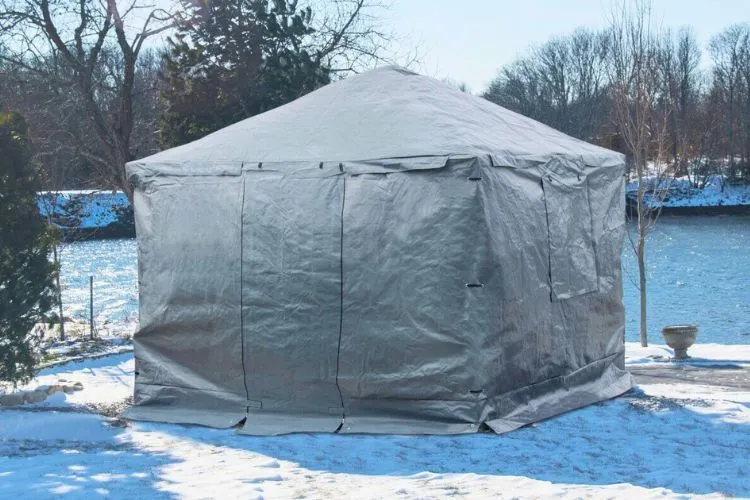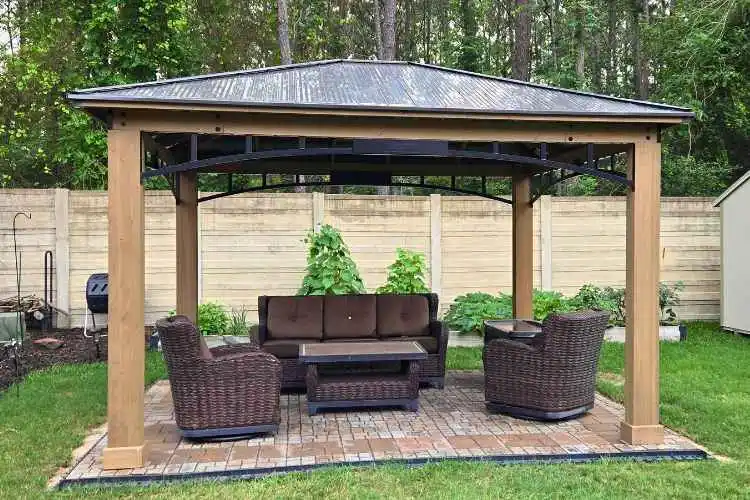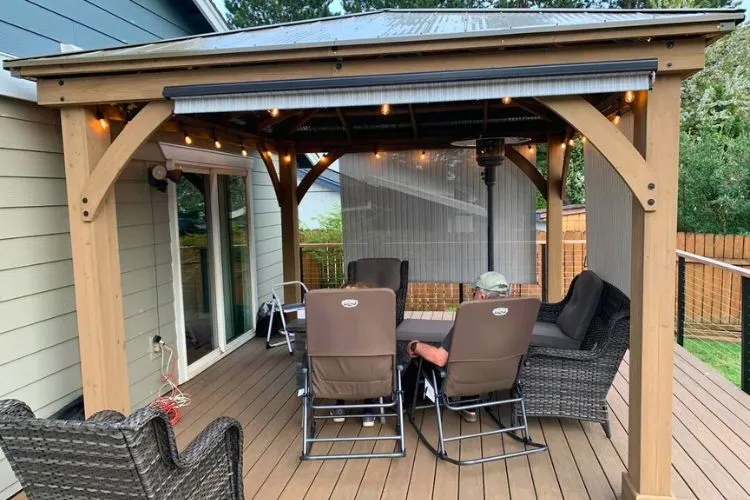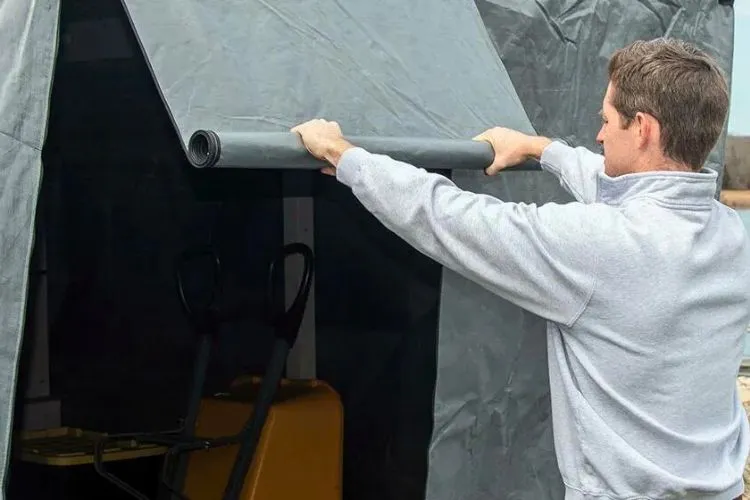As the leaves start to fall and the air turns crisp, homeowners with gazebos should begin thinking about winterization.
Taking the time to prepare your gazebo for the cold can prevent damage such as cracks, rot, and rust, ensuring its longevity and saving you money in the long run. So, how to winterize a gazebo?
Winterizing is a proactive measure that protects your investment against harsh weather and extends its usability for years to come.

Contents
How To Winterize A Gazebo?
Before winter arrives in full force, the first step is to inspect your gazebo thoroughly. Look over each component of the structure – from the roof down to the foundation – for any signs of damage.
Particular attention should be paid to the roof, as it bears the brunes of winter weather. Make note of any loose or damaged parts that need repair before the season’s first snow.
Cleaning and Repairs
A well-maintained gazebo is more likely to survive the winter unscathed. Begin with cleaning; remove dirt, leaves, and any debris that has accumulated.

A mild soap solution can be used for a thorough wipe-down. Don’t forget to clean out gutters and drains that can clog and cause water damage over the winter.
Next, address repairs. Tighten any loose screws or bolts, replace rotting or splintered wood pieces, and tend to rusted metal by sanding and coating it with a protective layer. Any tears in screens or canopies should be patched or replaced to prevent further tearing.
Protecting the Structure
Winter precipitation and freezing temps can wreak havoc on a gazebo. Treating wood with sealants will guard against moisture and pests.
Metal components benefit from a coat of rust-proofing spray. Check to see if parts of your gazebo need reinforcing to withstand the weight of ice and snow.
Even with a sturdy gazebo, it’s important to keep on top of snow and ice accumulation. Too much weight on the roof can lead to structural damage or even collapse.
After heavy snowfalls, sweep off snow using a broom with soft bristles to protect your gazebo without scratching the surfaces.
Securing and Sealing the Gazebo
Anchoring your gazebo will protect it against gusty winter winds. Whether by using foundation bolts or ground spikes, ensure that the gazebo is firmly attached to the ground.

Sealing is just as critical – use silicone caulk to fill any gaps in the structure. Pay close attention to areas where panels meet or where the gazebo attaches to the floor.
Covering and Insulation
While some gazebos are built to withstand the elements year-round, others benefit from the added protection of a cover.
Choose a water-resistant material that can hold up under the weight of snow. For added warmth and protection, insulate your gazebo with temporary materials like foam boards.
You may also read: How To Keep Your Gazebo Warm During Colder Weather?
Interior Considerations
The interior of your gazeadier should not be neglected. Furniture that can be damaged by the cold or moisture should be stored indoors.
For added protection against dampness, consider using desiccants or a dehumidifier to keep the interior dry.
Evaluating Weather Conditions
The importance of evaluating local weather conditions cannot be overstressed when it comes to winterizing your gazebo.
Different climates pose unique challenges; for instance, heavy snowfall areas demand robust roof support, while regions prone to high winds might require extra anchoring measures.
Understanding the severity and frequency of winter extremes—be it deep freezes, sleet, or ice storms—allows you to anticipate potential hazards and act accordingly.
Tailoring your winterization steps to your area’s specific needs not only ensures comprehensive protection but also prevents unnecessary efforts that don’t align with your climate.
By staying attuned to weather patterns and regional winter threats, you can effectively adapt your game plan, ensuring that your gazebo stands strong against the seasonal elements.
Winter Storage Solutions
When winterizing your gazebo, properly storing removable components such as curtains, nets, and fabric canopies is crucial to ensure their longevity and prevent damage from harsh winter conditions.

One effective storage solution is to use durable, breathable fabric bags or bins that allow airflow while keeping dust and pests at bay. Label each container clearly with its contents for easy identification.
For larger items, consider utilizing vacuum-seal bags to reduce storage space requirements. Ideally, these storage containers should be placed in a cool, dry area, such as a basement, garage, or dedicated storage shed, to protect against humidity and temperature fluctuations.
Additionally, you might hang heavier curtains or drapes in spare closets if space allows, ensuring they remain clean and free from folds or creases. Proper storage not only safeguards your gazebo accessories but also makes reinstallation simpler and faster when warmer weather returns.
Ventilation Over Winter
Maintaining proper airflow within your gazebo during the cold winter months is crucial to preventing the buildup of moisture, which can lead to mold and mildew formation.
Even in winter, it’s important to ensure some level of ventilation. One strategy is to slightly open any available vents or windows to allow air circulation, avoiding the creation of a completely sealed environment.
If your gazebo has retractable sides or panels, consider opening them on drier, sunnier days to let air flow through. For enclosed gazebos, a small, battery-operated fan can help circulate air without needing an external power source.
Implementing these simple airflow strategies will help keep the interior of your gazebo dry and free from damaging mold and mild conditions throughout the winter season.
Frequently Asked Questions (FAQs)
How often should I treat the wood of my gazebo for winter?
Treat wooden parts annually before winter to repel water and prevent damage.
Can I leave my fabric canopy on during winter?
It’s best to remove fabric canopies as they can tear under heavy snow.
What are the risks of not winterizing a gazebo?
Risks include structural damage, wood rot, rust, and deterioration of materials.
Is it necessary to remove snow after every snowfall?
Yes, to avoid accumulation that can stress and damage the structure.
Are there any specific products recommended for sealing wooden gazebos?
Use high-quality silicone caulk and water-repellant sealants designed for outdoor use.
Conclusion:
In conclusion, while winterizing your gazebo may seem like a daunting task, the steps are straightforward. Inspect, clean, repair, protect, manage snow, secure, seal, cover, and insulate.
By following these steps, your gazebo will be equipped to face the winter, ensuring its beauty and functionality for the following spring.

Sergio Gomes, a passionate advocate for outdoor living and the male voice behind Shades Authority. With years of experience, Sergio is your trusted source for expert insights on gazebos, pavilions, cabanas, pergolas, and all things outdoor shade solutions. Join him on a journey to transform your outdoor spaces into stunning, functional retreats
